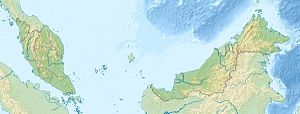Bakun dam
| Bakun Dam | |||||||
|---|---|---|---|---|---|---|---|
| Building site | |||||||
|
|||||||
|
|
|||||||
| Coordinates | 2 ° 45 '23 " N , 114 ° 3' 47" E | ||||||
| Data on the structure | |||||||
| Construction time: | 1996-2011 | ||||||
| Height above foundation level : | 205 m | ||||||
| Building volume: | 29.4 million m 3 | ||||||
| Crown length: | 900 m | ||||||
| Power plant output: | 2400 MW | ||||||
| Data on the reservoir | |||||||
| Water surface | 696.4 km 2 | ||||||
| Storage space | 43,800 million m 3 | ||||||
| Catchment area | 14,750 km 2 | ||||||
| Design flood : | 15,000 m 3 / s | ||||||
The Bakun Dam is a dam on the Balui , a tributary of the Rajang on the island of Borneo in Sarawak , Malaysia . The project was started in 1994 by the then Prime Minister Mahathir Mohammad . The main part of the project is a large, 205 m high dam , a rock debris dam , which, however, will by no means be the largest in international comparison. The planned power generation capacity is 2400 megawatts .
The construction costs should be 2.4 to 4 billion US dollars. Completion was originally planned for 2003, but was delayed until August 6, 2011.
history
The first investigations into the construction of a dam were carried out in the Bakun Dam region as early as the 1960s. Further research was then carried out in the 1980s.
- Start of construction: 1994
- First filling begins: October 14, 2010
- First filling completed: April 28, 2011
- First electricity production: August 6, 2011
disadvantage
For the reservoir , 9,000 to 10,000 indigenous people from five ethnic groups and longhouse communities had to make way. Although the dam construction has been delayed, they were involuntarily relocated between 1998 and 1999 to Sungai Asap, 30 km from the dam. 230 km 2 of tropical rainforest are lost through the reservoir . An increase in diseases such as schistosomiasis , opisthorchiosis , malaria and filariasis is expected . The gene pool of various local grain and plant species is endangered. It is also feared that sediment deposits will reduce the usable storage space and the useful life of the dam. A possible failure of the dam was also feared.
purpose
The purpose of the dam is to meet the growing demand for electricity. However, this need is mainly in the western peninsula of Malaysia, not in east Malaysia, where the dam is located. Original plans were for 30% of the electricity generated in East Malaysia to be used and the rest, up to 90% according to other sources, to be sent to the peninsula. This plan provided for 668 km of overhead lines, 643 km of submarine cables and 458 km of cables on the peninsula.
Originally, the dam was to be built by a joint venture between Ekran Berhad, Tenaga Nasional Berhad (TNB), the Government of Sarawak , Sarawak Electricity Supply Corporation (Sesco), and Malaysia Mining Corporation Bhd (MMC). The operator should be the private Ekran owned Bakun Hydroelectric Corporation Berhad (BHC). Ekran, with chairman Ting Pek Khing, issued subscription rights to fund the project, but it was underfunded and Ekran had to raise $ 500 million in lieu of the unspent shares. The main contractors for the construction work were ABB , Companhia Brasileira de Projetos e Obras and Dong Ah from South Korea.
Interruptions, delays and planning changes
In November 1997 the project was interrupted due to the Asian crisis . The Malaysian government withdrew the project from the consortium. At that time, 1.6 billion ringgit had already been issued to Global Upline (a company owned by Ting Pek Khing) to remove biomass from the reservoir, for a cofferdam , and for relocation. In addition, eight turbines had already been bought for 1 billion RM.
In 2000 the project was revived. The power line to the peninsula was no longer included. The output of the hydropower plant was reduced to 700 MW. A new consortium led by Sime Engineering Berhad was established. The old consortium (BHC, Ekran, Dong Ah and others) received 250 million from tax revenues as compensation. The new completion date was September 2007. The total planned amount to be paid to the consortium was RM 1.8 billion.
In May 2004, Ting Pek Khing's Global Upline got a contract to remove biomass from the storage space. That would have allowed him to cut wood there without special permission. These permits are now subject to restrictive political and ecological conditions.
To use the electricity, an aluminum plant was planned in Similajau , Bintulu , about 180 km from the dam. This is a joint venture between Dubal and the Gulf International Investment Group (GIIG). The plant should use 50% of the electricity generated. The government has cleared 60% of Sarawak Hidro, the dam's owner, to be sold to GIIG. Due to the delays in the construction of the dam, the plans for the aluminum plant have also been postponed. Future plans include a connection to a power grid, the power to Sarawak, Sabah , Brunei and Kalimantan ( Indonesia ) will supply.
So far only losses have been made with the project. Today it is being considered to continue building Bakun in its original size. The project is said to violate a number of guidelines of the World Commission on Dams (WCD).
See also
Web links
- Background… Bakun Story on bakundam.com
- Internationalrivers.org: Bakun Dam, Malaysia
- Anil Netto: Dirty Dam Draws Dirty Smelters. In: Asian Times Online. January 25, 2006, accessed July 20, 2013 .
- The Star : M'sia Offers to Sell Bakun Power to Indonesia, April 23, 2009.
Individual evidence
- ^ Peter Sibon: Energy Boost from Bakun. In: The Borneo Post. August 6, 2011, accessed July 19, 2013 .


